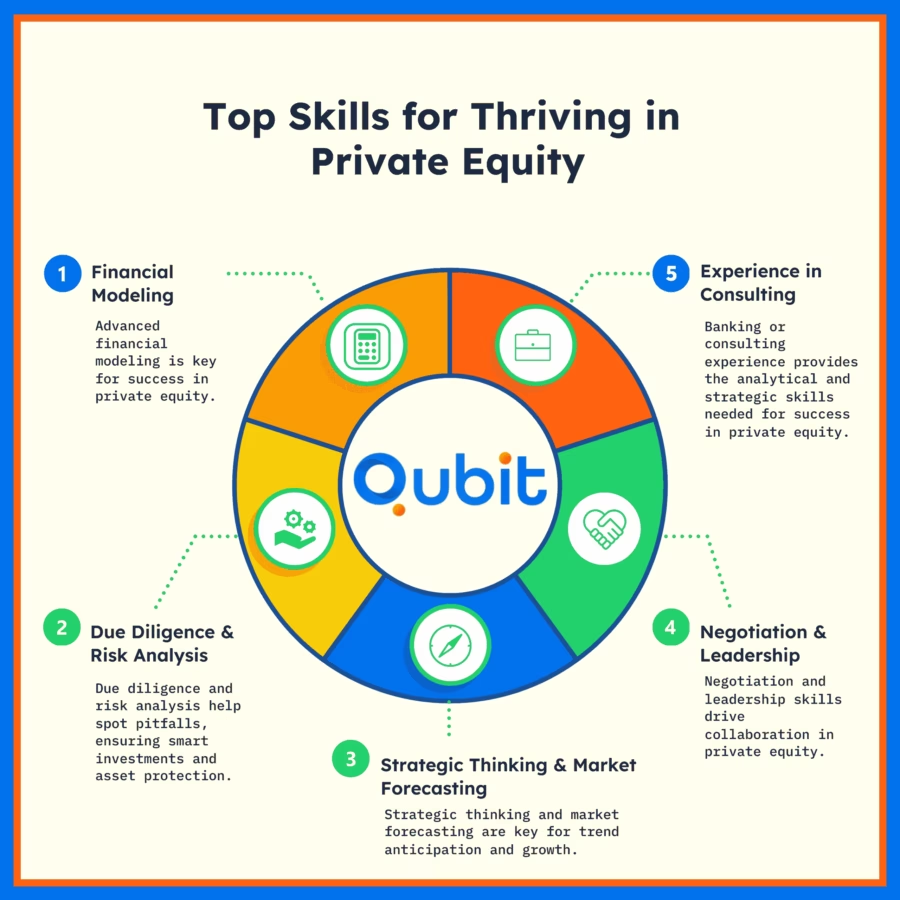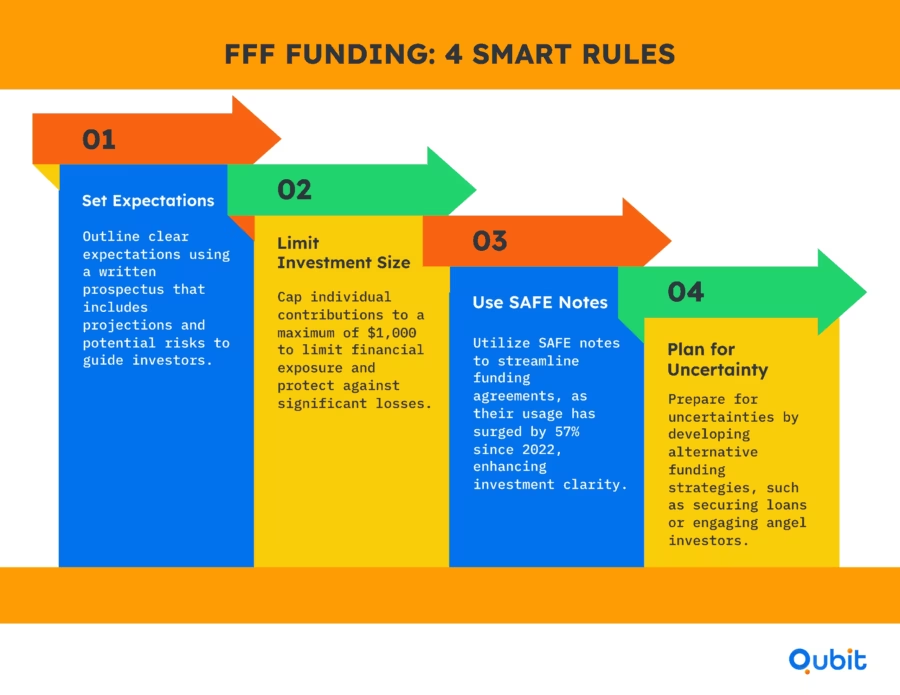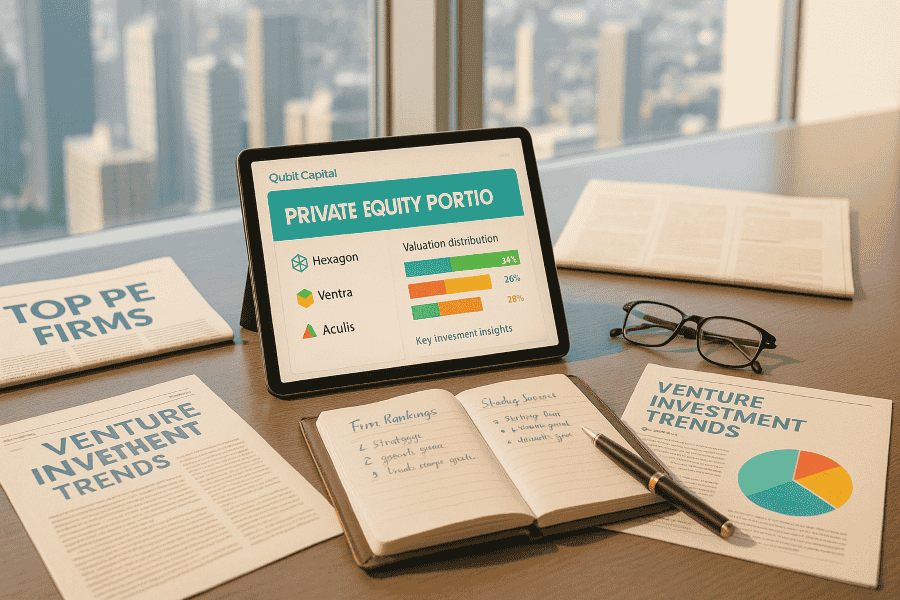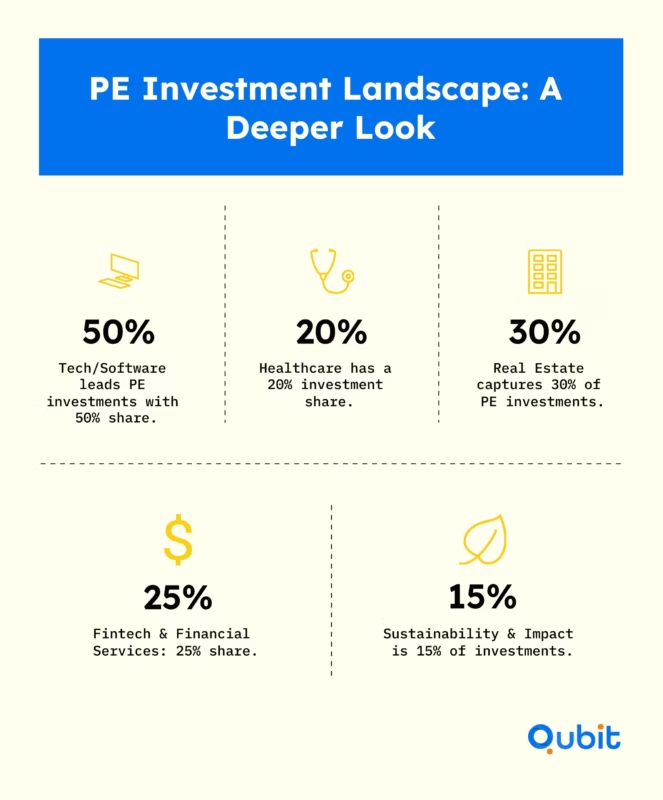Private equity can feel like strapping a rocket booster to a young company. Beyond the injection of capital, seasoned deal makers roll up their sleeves—refining supply chains, opening boardroom doors, and setting the stage for an eventual billion-dollar exit. Yet the road to that partnership begins long before the term sheet lands on your desk. Founders must curate a watertight data room, anticipate probing due-diligence questions, and hold their nerve when valuation chess matches begin.
Put side by side with the many types of startup funding, available, private equity sits at the intersection of deep pockets and hands-on guidance—ideal once product-market fit is proven and the next act demands serious scale.
In this article, we’ll break down every critical step: building an information vault investors can trust, steering negotiations without losing strategic control, and setting milestones that convert institutional confidence into lasting momentum.
What You Need to Know About Private Equity Basics
Private equity (PE) represents a unique investment model focused on privately held companies that are not listed on public exchanges. Unlike traditional stock market investments, PE involves acquiring stakes in businesses with the goal of driving strategic growth or restructuring. This approach often targets companies with untapped potential, aiming to enhance their value over time.
One defining characteristic of private equity investments is their long-term, illiquid nature. Investors commit capital for extended periods, typically ranging from five to ten years, during which the funds are locked in. This illiquidity reflects the strategic focus of PE firms, as they work closely with portfolio companies to implement operational improvements, expand market reach, or execute turnaround strategies.
Private equity attracts a specific group of investors, including institutional entities like pension funds, endowments, and high-net-worth individuals. These investors are drawn to the potential for substantial returns, which often exceed those of public market investments. However, the commitment required is significant, as PE investments demand patience and a willingness to engage in a long-term strategy.
The scale of the private market is immense, with over six million private companies in the U.S. alone, compared to less than 1% that are publicly traded. This statistic underscores the vast opportunities available for private equity firms to identify and invest in promising businesses.
For those weighing their funding options, the comparison between venture capital vs private equity can clarify how each model supports business growth. Balanced perspectives emerge in ‘venture capital vs private equity’, which outlines the distinctive characteristics between these two funding models.
How to Navigate the Private Equity Investment Process
The private equity investment process is a meticulous journey, structured to ensure each phase builds upon the previous one. From identifying promising opportunities to crafting strategic exits, every step demands precision and foresight. Below, we break down the process into actionable stages, providing clarity for founders and investors alike.
1. Fundraising: Building the Foundation
Fundraising is the initial step where private equity firms secure capital from institutional investors, high-net-worth individuals, and other sources. This phase involves presenting compelling investment theses and demonstrating a track record of success. Clear communication and transparency are critical to gaining investor trust.
2. Deal Sourcing: Identifying Opportunities
The search for potential investments begins with deal sourcing. Firms analyze industries, market trends, and company performance to identify promising targets. Tools like the Deal Sourcing Guide offer effective strategies for refining lead generation approaches, ensuring firms focus on high-potential opportunities.
3. Due Diligence: Evaluating the Target
Due diligence is a cornerstone of the private equity process, involving a thorough examination of financials, operations, and market positioning. Using a private equity data room, such as DealRoom, ensures secure communication and efficient management of confidential data during this phase.
4. Internal Operating Models: Structuring Success
Once an investment is identified, firms develop internal operating models to optimize the target company’s performance. These models focus on streamlining operations, enhancing profitability, and preparing the company for future growth.
5. Crafting Preliminary Memoranda: Communicating Value
Preliminary memoranda are created to summarize the investment opportunity, highlighting key findings from due diligence and the proposed strategy. These documents are shared with stakeholders to ensure alignment and secure approval for the next steps.
6. Managing Acquired Companies: Driving Growth
Post-acquisition, private equity firms focus on driving growth through operational improvements, strategic initiatives, and bolt-on acquisitions. Resources like Bolt-On Strategies provide insights into identifying synergistic acquisitions that enhance the acquired company’s market reach and product offerings.
7. Planning Strategic Exits: Maximizing Returns
The final phase involves planning a strategic exit to maximize returns. Whether through an IPO, sale, or merger, timing and market conditions play a crucial role. The Exit Plan Guidelines offer methodologies for structuring a strong exit plan that minimizes disruptions and optimizes outcomes.
By following this structured process, private equity firms can ensure each phase contributes to long-term success.
Learn from a Real-World Private Equity Deal Example
Few private equity transactions have captured the industry’s attention like Blackstone’s $26 billion acquisition of Hilton Hotels. This landmark deal serves as a powerful example of how strategic restructuring and precise timing can transform an investment into a resounding success.
Blackstone’s approach to Hilton involved a combination of financial engineering and operational refinement. The acquisition was structured as a leveraged buyout, enabling Blackstone to secure the deal while minimizing upfront capital. Following the purchase, Blackstone focused on repositioning Hilton’s brand and expanding its global footprint. Operational improvements, such as streamlining management processes and enhancing customer experience, played a pivotal role in boosting profitability.
Timing was equally critical. Blackstone capitalized on favorable market conditions during the economic recovery, executing a public offering of Hilton in 2013. This strategic exit resulted in a valuation of over $30 billion, marking one of the most successful exits in private equity history.
For those seeking actionable insights, the Blackstone Hilton Acquisition stands as a hallmark case study on brand repositioning and expansion. Additionally, the LBO Guide provides a broader understanding of financing structures and outcomes in similar deals. Together, these resources offer a benchmark for best practices in large-scale private equity investments.
Private Equity Funds and Strategies You Can Use
Private equity (PE) funds are built on a partnership model that combines expertise and capital to drive returns. These funds typically operate with a general partner (GP), who manages the fund and makes investment decisions, and limited partners (LPs), who provide the capital. The fee structure often follows the 2-and-20 model, where GPs charge a 2% management fee and retain 20% of the profits as performance fees. This structure incentivizes GPs to maximize returns for their investors. For a detailed breakdown of partnership agreements and compensation layouts, refer to the PE Funds resource.
Types of Private Equity Funds
Private equity funds cater to diverse investment strategies, each with unique risk-return profiles:
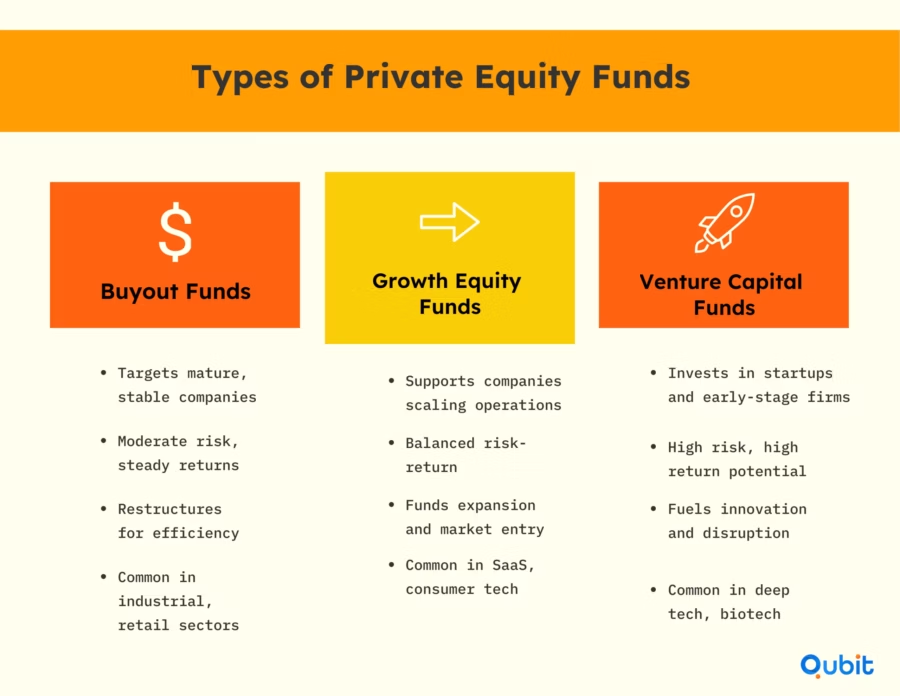
- Buyout Funds: These funds focus on acquiring controlling stakes in established companies, often restructuring operations to enhance profitability. Buyout funds are ideal for investors seeking steady returns with moderate risk.
- Growth Equity Funds: Targeting companies in their expansion phase, growth equity funds provide capital to scale operations, enter new markets, or develop products. These funds balance risk and reward, appealing to investors looking for growth potential without the volatility of early-stage ventures.
- Venture Capital Funds: Venture capital funds invest in startups and early-stage companies, often in technology or innovation-driven sectors. While these funds carry higher risk, they also offer the potential for outsized returns.
Fee Models and Returns
The fee models in private equity are designed to align the interests of GPs and LPs. The 2-and-20 structure ensures that fund managers are motivated to deliver strong performance while covering operational costs. For investors, understanding these fees is crucial to evaluating the net returns of a fund.
Private equity funds offer tailored strategies for different investment goals, making them a versatile option for portfolio diversification.
Ways to Access Private Equity Investment Opportunities
Private equity investment opportunities are no longer exclusive to institutional giants. Individual accredited investors and smaller institutions can now explore alternative pathways like co-investments and secondary transactions, which offer flexibility in fees and liquidity.
Co-Investments: A Collaborative Entry Point
Co-investments provide a unique chance for smaller investors to participate alongside established private equity funds. These arrangements often come with favorable fee structures, reducing the cost burden compared to traditional fund investments. By joining forces with larger entities, investors gain access to high-quality deals without the typical management and performance fees.
Secondary Transactions: Liquidity with Competitive Returns
Secondary transactions open doors for investors seeking liquidity or entry into existing private equity stakes. These transactions allow the buying and selling of pre-existing investments, often targeting returns in the range of 15–18%, as highlighted by the M&A Value statistic. This approach offers a secure process for investors, combining flexibility with the potential for attractive yields.
The friends and family funding pros and cons offer context for early-stage founders considering informal capital, a nuanced alternative approach . This resource contrasts PE-based funding with informal options, offering insights into risk and relationship implications.
By exploring co-investments and secondary transactions, investors can diversify their portfolios while enjoying tailored fee arrangements and liquidity options.
Understand the Key Phases of Private Equity Funds
Private equity funds operate through three distinct phases, each requiring a strategic focus to ensure optimal outcomes. These phases—Portfolio Construction, Value Creation, and Harvest—form the backbone of a successful investment cycle.
Portfolio Construction: Building a Strong Foundation
The first phase centers on identifying and acquiring high-potential investments. Conducting thorough due diligence is critical to selecting quality deals from a vast pool of opportunities. For instance, with approximately 735,000 privately owned middle-market businesses in the U.S., representing 99% of the market, private equity firms have an extensive selection pool to build their portfolios. This data highlights the importance of meticulous evaluation to pinpoint businesses with the highest growth potential.
Value Creation: Driving Growth
Once investments are secured, the focus shifts to enhancing their value. Active management during this phase can deliver above-market returns by optimizing operations, improving financial performance, and fostering strategic growth. Many private equity portfolios have historically outperformed public benchmarks, delivering a material return premium. This underscores the importance of hands-on involvement to unlock the full potential of portfolio companies.
Harvest: Timing the Exit
The final phase revolves around exiting investments at the right time to maximize returns for investors. Strategic timing and market analysis are essential to ensure that the harvest phase yields the highest possible value.
Understanding these phases equips investors with the knowledge to build and realize robust portfolios effectively.
Key Things Private Equity Investors Should Keep in Mind
Private equity offers unique opportunities, but it also comes with specific challenges that investors must carefully evaluate. One critical consideration is the illiquidity of private equity investments. These funds often require long lock-up periods, meaning your capital could be tied up for years. This makes it essential to assess your liquidity needs before committing.
Another factor to weigh is the diversification benefits private equity can bring to your portfolio. With a low correlation to public markets, private equity investments can help stabilize returns during volatile market cycles. This characteristic can be particularly appealing for those looking to mitigate risks associated with traditional equity markets.
However, the potential for high returns comes with costs. Private equity fee structures, including management fees and carried interest, can significantly impact net returns. Understanding these costs upfront is crucial to ensure they align with your financial goals.
Finally, alignment of interests between investors and fund managers is key. Misaligned incentives can lead to suboptimal outcomes, so it’s worth exploring this topic further. The discussion in working with private equity pros and cons presents a clear analysis of both the benefits and potential drawbacks when engaging with private equity firms.
By keeping these factors in mind, investors can make more informed decisions and better position themselves for success in the private equity space.
Increase Your Deal Flow in Private Equity
A steady pipeline of quality deals is the backbone of successful private equity operations. Building and maintaining this flow requires a combination of strategic networking, deep industry knowledge, and the adoption of advanced digital tools. Robust connections within the industry not only open doors to exclusive opportunities but also ensure access to reliable insights that can shape investment decisions.
Digital tools, such as Deal Flow Software, simplify the process of sourcing, evaluating, and tracking potential investments. By adopting Deal Flow Software, firms can coordinate leads and monitor deal stages with minimal administrative effort, allowing teams to focus on high-value activities.
Maintaining consistent deal flow is essential for sustained growth in private equity. Combining technology with expertise and relationships ensures firms remain competitive while identifying opportunities that align with their investment strategies.
How Eqvista Can Help You Manage Your Equity
Managing equity effectively can be challenging, but platforms like Eqvista simplify the process. With tools designed for secure process management, Eqvista enables businesses to track shares, automate valuations, and maintain accurate cap tables. This transparency fosters trust and strengthens communication with investors. Additionally, Eqvista offers permissioned data sharing, which complements traditional virtual data room investment banking practices, ensuring sensitive ownership data remains protected.
For startups preparing for investment, understanding equity readiness is crucial. Explore more about this in our guide on preparing startup for private equity, which outlines essential measures for organizing cap tables and financials.
Conclusion
Private equity investments thrive on a structured approach, where understanding fund types and investor priorities plays a pivotal role. Digital tools have become indispensable in streamlining processes, offering clarity and efficiency to both investors and startups. Equally important is crafting a compelling narrative that aligns with the expectations of private equity stakeholders.
At Qubit Capital, we specialize in connecting startups with the right investors. Our Investor Discovery and Mapping service uses AI-driven insights to identify best-fit investors tailored to your goals. Let’s work together to secure the partnerships that drive success.
Key Takeaways
Private equity investments operate through a structured, multi-stage process — from fundraising and deal sourcing to portfolio management and final exit — each stage critical to overall success.
Leveraging digital tools such as DealRoom and secure private equity data rooms significantly enhances efficiency, collaboration, and transparency throughout the deal lifecycle.
Case studies like Blackstone’s acquisition and turnaround of Hilton illustrate how strategic restructuring and well-timed exits can generate substantial returns and set industry benchmarks.
A solid understanding of different fund structures (e.g., buyout, growth, and venture capital) and the three core phases of the PE cycle can empower both investors and founders to make smarter, more aligned decisions.
Platforms like Eqvista streamline equity management, ensuring cap table accuracy, enhancing stakeholder transparency, and reinforcing investor confidence throughout the investment journey.






